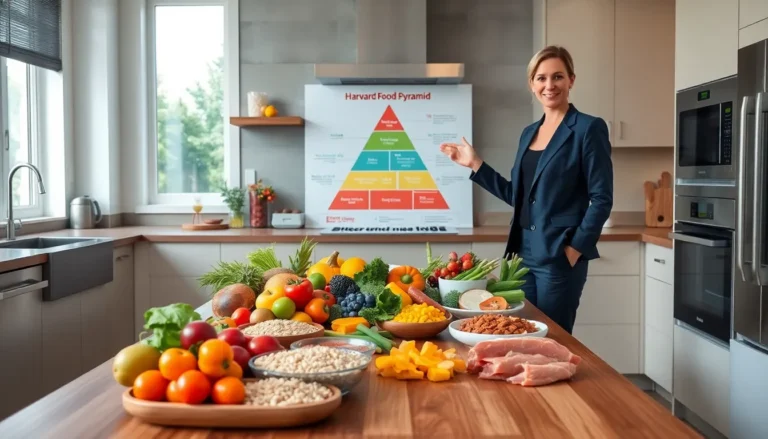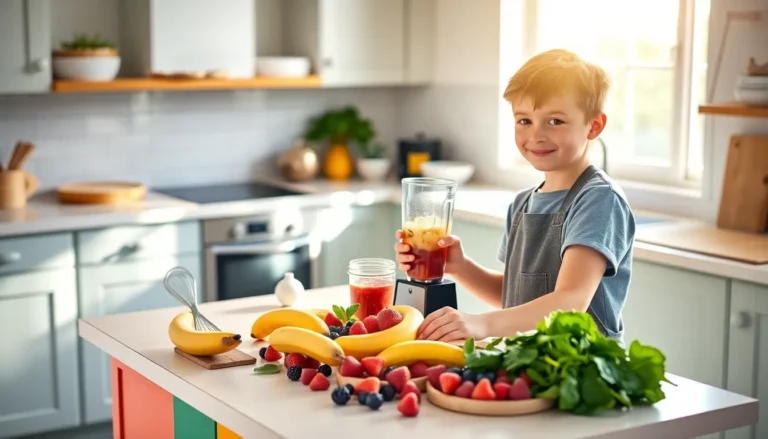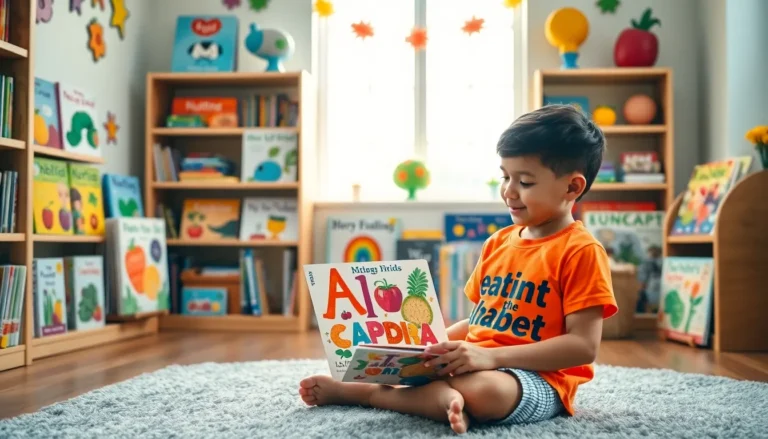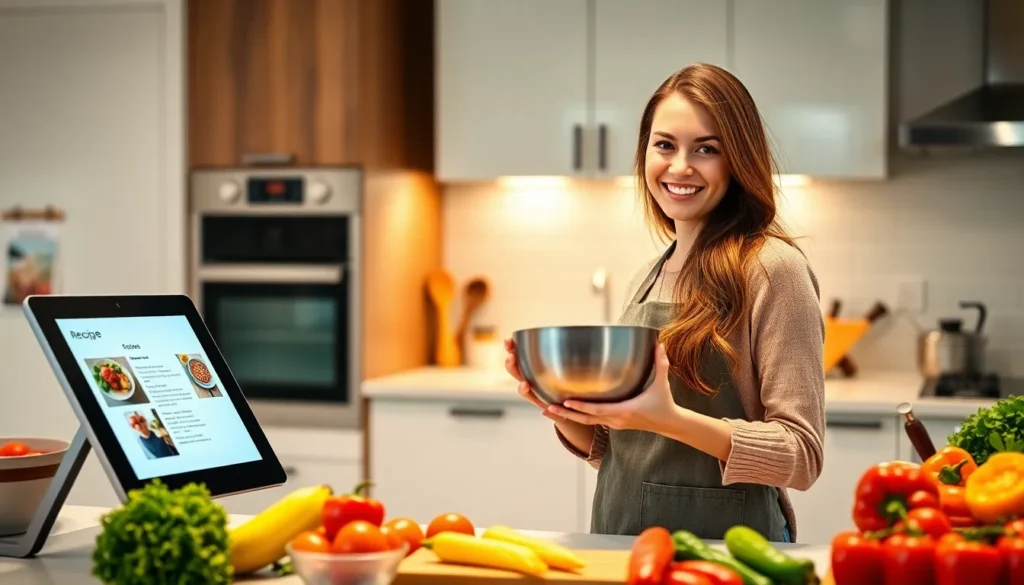Table of Contents
ToggleIn a world where technology meets culinary creativity, interactive recipe books are transforming the way people cook. These innovative tools combine traditional recipes with engaging multimedia elements, making cooking not just a task but an experience. With features like step-by-step videos, voice commands, and personalized meal plans, they cater to both novice cooks and seasoned chefs alike.
Gone are the days of flipping through static pages; interactive recipe books bring a dynamic approach to meal preparation. They allow users to explore flavors, techniques, and cuisines in a way that feels intuitive and fun. As home cooking continues to rise in popularity, these books are becoming essential companions in kitchens everywhere, bridging the gap between technology and gastronomy.
Overview of Interactive Recipe Books
Interactive recipe books combine technology with culinary instruction, transforming traditional cooking methods. These books integrate various multimedia elements, enhancing user experience. Features often include:
- Step-by-step videos: Visual demonstrations help clarify complex techniques.
- Voice commands: Hands-free navigation allows cooks to follow instructions without interruptions.
- Personalized meal plans: Customization options cater to dietary needs and preferences.
Interactive recipe books cater to a wide audience, from novices seeking guidance to seasoned chefs exploring new cuisines. They foster creativity in the kitchen by encouraging experimentation and offering diverse culinary resources. The incorporation of technology engages users, making meal preparation more enjoyable. Moreover, the dynamic nature of these books promotes the growth of home cooking, solidifying their role as indispensable kitchen tools.
Features of Interactive Recipe Books

Interactive recipe books include various features that enhance the cooking experience. These elements improve user engagement and simplify meal preparation.
User Interface and Experience
User interface design prioritizes simplicity and accessibility. Intuitive navigation ensures users easily find recipes and instructions. Touchscreen compatibility allows for quick interaction, reducing the time spent searching for information. Customization options enable users to save favorite recipes and create personalized meal plans, enhancing overall satisfaction.
Multimedia Elements
Multimedia elements play a crucial role in the effectiveness of interactive recipe books. Step-by-step videos offer visual guidance, making complex cooking techniques easier to understand. High-quality images of finished dishes inspire creativity and provide a clear reference. Voice commands integrate hands-free operation, allowing users to follow recipes without needing to touch their devices. Additional elements, like interactive timers and ingredient substitutions, further streamline the cooking process and enhance usability.
Benefits of Using Interactive Recipe Books
Interactive recipe books offer significant advantages for cooks of all skill levels. They enhance learning, improve cooking skills, and provide convenience in the kitchen.
Enhanced Learning and Cooking Skills
Interactive recipe books promote enhanced learning through various multimedia features. Step-by-step videos clarify complex techniques, making it easier to master skills such as knife handling or sauce preparation. Voice commands facilitate hands-free navigation throughout the cooking process, allowing cooks to focus on their tasks without constant interruptions. Personalized feedback, often included in these tools, helps users refine techniques based on their progress. Overall, these dynamic elements foster a supportive learning environment that can boost confidence and proficiency in the kitchen.
Accessibility and Convenience
Interactive recipe books increase accessibility and convenience for users during meal preparation. Touchscreen compatibility allows for quick recipe searches and easy on-screen adjustments. Users can save favorite recipes and create personalized meal plans, streamlining the overall cooking experience. High-quality images and interactive timers eliminate guesswork, guiding cooks through each step clearly. This combination of features makes cooking more enjoyable and efficient, encouraging users to experiment and innovate in their culinary endeavors.
Popular Interactive Recipe Books on the Market
Several interactive recipe books stand out in today’s culinary landscape, offering unique features that enhance the cooking experience.
| Title | Key Features | Price Range |
|---|---|---|
| Cook Smarts | Custom meal plans, step-by-step videos, and user-friendly interface | $4.99/month |
| Tasty App | Short video recipes, hands-free voice commands, and social sharing | Free with in-app purchases |
| Yummly | Personalized recommendations, shopping list integration, and interactive tutorials | Free with premium options |
| SideChef | Voice guidance, step-by-step photos, and ingredient substitution features | Free with in-app purchases |
| BigOven | Recipe organization, meal planning tools, and shopping list automation | Free with premium options |
- Cook Smarts: Offers tailored meal plans based on dietary restrictions. Its multimedia elements include instructional videos that simplify various cooking techniques.
- Tasty App: Focuses on quick, visually appealing recipes available in video format. The app’s voice commands facilitate hands-free cooking, allowing cooks to concentrate on their tasks.
- Yummly: Provides personalized recipe suggestions aligned with individual tastes. Its features include an interactive tutorial section that assists users with cooking techniques and ingredient choices.
- SideChef: Allows cooks to navigate recipes using voice controls. Step-by-step photos guide users through complex dishes, ensuring each step is easily accessible.
- BigOven: Features recipe organization tools that help users manage their favorite dishes effectively. Its automated shopping list function streamlines ingredient gathering for meal preparation.
These interactive recipe books exemplify the growing trend of technology integration in cooking, making meal preparation accessible and enjoyable for a wide range of culinary enthusiasts.
Potential Drawbacks of Interactive Recipe Books
Interactive recipe books present certain challenges that may affect user experience.
- Dependency on Technology
Many interactive recipe books rely on devices for functionality. Users without reliable internet access may encounter limitations, particularly when needing to access specific features or downloads.
- Learning Curve
Some individuals, particularly those unfamiliar with technology, may face a steep learning curve. Navigating complex interfaces can frustrate users who prefer straightforward, traditional recipe formats.
- Screen Fatigue
Prolonged use of electronic screens can lead to visual discomfort and fatigue. Users who spend extensive time cooking or following recipes may experience eye strain or distractions.
- Cost
Interactive recipe books often cost more than traditional cookbooks. Initial investments in devices or subscriptions can deter potential users from embracing these innovative tools.
- Limited Personal Touch
Many cooks enjoy the tactile experience of flipping through a book or jotting down notes in the margins. Interactive books may lack this personal connection, diminishing the joy of culinary exploration.
- Inconsistent Content Quality
The quality of interactive features varies across different products. Users may encounter inconsistencies in the accuracy of recipes and multimedia content, which can undermine confidence in cooking.
- Hardware Compatibility
Some users may face challenges with compatibility between interactive recipe books and their devices. Issues with operating systems or outdated hardware can limit functionality and access to features.
Interactive recipe books are transforming the way people approach cooking. By seamlessly integrating technology with culinary arts they create an engaging and supportive environment for cooks of all skill levels. The multimedia features not only enhance learning but also inspire creativity in the kitchen.
While there are some challenges associated with these modern tools such as dependency on technology and potential learning curves the benefits often outweigh the drawbacks. As home cooking continues to rise in popularity interactive recipe books stand out as essential companions that make meal preparation more enjoyable and efficient. Embracing these innovative resources can lead to a more fulfilling cooking experience and a greater appreciation for the art of food preparation.







